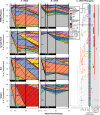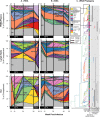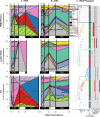A spatio-temporal assessment of simian/human immunodeficiency virus (SHIV) evolution reveals a highly dynamic process within the host
- PMID: 28542550
- PMCID: PMC5444849
- DOI: 10.1371/journal.ppat.1006358
A spatio-temporal assessment of simian/human immunodeficiency virus (SHIV) evolution reveals a highly dynamic process within the host
Abstract
The process by which drug-resistant HIV-1 arises and spreads spatially within an infected individual is poorly understood. Studies have found variable results relating how HIV-1 in the blood differs from virus sampled in tissues, offering conflicting findings about whether HIV-1 throughout the body is homogeneously distributed. However, most of these studies sample only two compartments and few have data from multiple time points. To directly measure how drug resistance spreads within a host and to assess how spatial structure impacts its emergence, we examined serial sequences from four macaques infected with RT-SHIVmne027, a simian immunodeficiency virus encoding HIV-1 reverse transcriptase (RT), and treated with RT inhibitors. Both viral DNA and RNA (vDNA and vRNA) were isolated from the blood (including plasma and peripheral blood mononuclear cells), lymph nodes, gut, and vagina at a median of four time points and RT was characterized via single-genome sequencing. The resulting sequences reveal a dynamic system in which vRNA rapidly acquires drug resistance concomitantly across compartments through multiple independent mutations. Fast migration results in the same viral genotypes present across compartments, but not so fast as to equilibrate their frequencies immediately. The blood and lymph nodes were found to be compartmentalized rarely, while both the blood and lymph node were more frequently different from mucosal tissues. This study suggests that even oft-sampled blood does not fully capture the viral dynamics in other parts of the body, especially the gut where vRNA turnover was faster than the plasma and vDNA retained fewer wild-type viruses than other sampled compartments. Our findings of transient compartmentalization across multiple tissues may help explain the varied results of previous compartmentalization studies in HIV-1.
Conflict of interest statement
BFK is employed by Leidos Biomedical Research, Inc. The authors have declared that no competing interests exist.
Figures








References
-
- Cory TJ, Schacker TW, Stevenson M, Fletcher CV. Overcoming pharmacologic sanctuaries. Current opinion in HIV and AIDS. 2013;8:190–5. doi: 10.1097/COH.0b013e32835fc68a - DOI - PMC - PubMed
-
- Lorenzo-Redondo R, Fryer HR, Bedford T, Kim E-Y, Archer J, Kosakovsky Pond SL, et al. Persistent HIV-1 replication maintains the tissue reservoir during therapy. Nature. 2016;530(7588):51–6. doi: 10.1038/nature16933 - DOI - PMC - PubMed
-
- Moreno-Gamez S, Hill AL, Rosenbloom DIS, Petrov DA, Nowak MA, Pennings PS. Imperfect drug penetration leads to spatial monotherapy and rapid evolution of multidrug resistance. Proceedings of the National Academy of Sciences of the United States of America. 2015;112:E2874–83. doi: 10.1073/pnas.1424184112 - DOI - PMC - PubMed
-
- Bull ME, Heath LM, McKernan-Mullin JL, Kraft KM, Acevedo L, Hitti JE, et al. Human immunodeficiency viruses appear compartmentalized to the female genital tract in cross-sectional analyses but genital lineages do not persist over time. The Journal of infectious diseases. 2013;207:1206–15. doi: 10.1093/infdis/jit016 - DOI - PMC - PubMed
MeSH terms
Substances
Grants and funding
LinkOut - more resources
Full Text Sources
Other Literature Sources
Medical
Molecular Biology Databases

